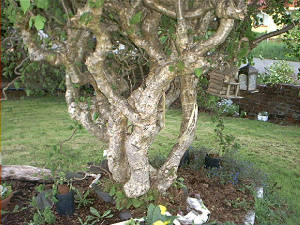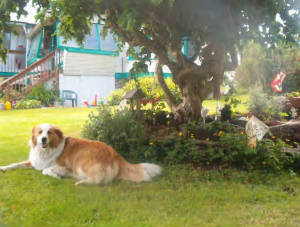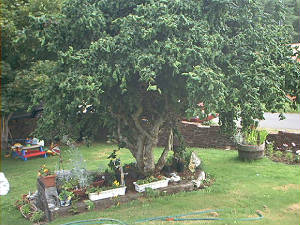
Click on photo link above to get to Folgers link for 'how to' and downloadable prints to decorate your holiday canister.

More on page on this website (see tabs above) dedicated to ‘Storm of the Decade, Pacific Northwest, December 2007′
Today is Friday, Dec 7, 2007 and we just got power back yesterday, Thursday, Dec 6, 2007, after being without power, communications, access in or out of the county since the storm hit last Sunday, Dec 2, 2007. It was what it was advertised by the Chinook Observer to be - the storm of the decade and it affected most all of Washington coastline with grave flooding inland and great parts of Oregon coastline. Most hard hit with massive flooding was Lewis County and Grays Harbor County, our neighboring counties. Pacific County was hit hard too, enough to collapse a seemingly fragile infrastructure; no power, no land phones, no cell phones, no 911, no access in or out of the county and even emergency communications out of county to notify status were limited and curtailed. It was an eerie feeling to be so completely cut off.
Later as the week wore on the reality of not being able to access our own bank account or get gas as gas pumps need electricity to work, and word of possible contamination of water in South Bend/Raymond, the fragility of the infrastructure not only in our own county but any county became evident to me. We must learn to rely on individual preparedness, and preparedness and help from among our community to see us through those early days of catastrophic weather events. And given what we experienced with this storm, I'm inclined to believe that with climate warming, we will see other such storms, perhaps not at that magnitude, but enough to cause breaks in the infrastructure here in Pacific County and in neighboring counties.
Sorting out how to tell parts of the story, and rather than one big fat blog entry, I will want to break it down some. For the days without power and communications (phones, cell phones, 911, emergency access), I started a journal. Now that we have power back and I am seeing via internet news all the devastation around us in our own county and neighboring counties, I recognize we are among the very fortunate.
Providing the link to the Washblog interview Noemie did with me when she phoned me yesterday to check up on us where she gives an account of what I shared with her.
Report from Lietta Ruger: Storm Causes Complete Infrastructure Collapse in Pacific Co.
By noemie maxwell
Thu Dec 06, 2007 at 03:37:50 PM PST
Section: Pacific County Topic: Climate ChangeI just spoke with Lietta Ruger, one of Washblog's editors, and she asked me to post a little summary of our conversation. She plans to post something more in-depth later.
She and Arthur Ruger live in the Willapa Bay community in Bay Center. There is no locally owned broadcast media in the area, and so they rely primarily on King 5 TV for their storm warnings. KIRO and KOMO generally don't provide coverage on their area. She said that no warnings came through mainstream media on the severe impacts that their community was expected to face from the impending storm last weekend. It was only because they happen to subscribe to what she describes as a tiny newspaper, a weekly called The Chinook Observer, that she learned her community was facing perhaps "the storm of the decade."
Having received this one warning, she and Arthur brought out their candles and blankets and cooked up the food in their refrigerator and battened down the hatches - just in case. The storm hit on Sunday and the three of them - including Lietta's mother - stayed indoors for two days as winds up to 119 miles an hour raged outside. There was no electricity, no phone service, no cellphone service. After the storm subsided, the roads were so impassible in every direction, and the power outage and the lack of emergency service so complete -- that as far as people in her community knew, they might have separated from the rest of the United States and floated off into the Pacific Ocean.
It wasn't until yesterday that a local store selling crank radios opened and she and Arthur were able to tune into coverage from Astoria, Oregon to find out the extent of the damage to the rest of Washington state.
Even then, most of the stores remained locked, the social services office, where emergency help is usually offered, remained closed and dark. The gas pumps, which run on electricity, don't work. People who have medical emergencies are out of luck. And at least one woman did die, when her house caught on fire from the candles she was using to provide light.
There was no safe way to travel by water, either, because the water was moving too fast and there were too many other dangers, low tree branches, objects, etc. Even the county's weather monitoring equipment failed. We know that winds reached 119 mph in Bay Center and 120 mph in Astoria, she said, because private citizens had equipment that withstood the wind, while the wind broke the county's equipment.
The problem wasn't with community members. People helped each other quite a bit. In fact, the owner of the Bay Center grocery store, a woman named Lori, drove from Long Beach through all the hazards to Bay Center and fired up the generator and stove and cooked soups and made sandwiches to serve the people in that community. And her husband and son did that in the other grocery stores owned by the family in other nearby communities. But now that the electricity has come back on, and she's learned that the rest of the world is still here -- though Grays Harbon and Lewis Counties appear to have suffered even more -- now she's feeling pretty upset.
This is a warning, she said, that we need to get our act together on emergency preparedness. We are experiencing the effects of climate change and we can expect more. This kind of storm is not on the usual scale. It's a clear signal, as well, that we need some major changes in how we do media. Pacific County needs its own broadcast media. We talked for awhile about testimony at the recent FCC hearing in Seattle that local communities are endangered by the centralization of broadcast media. That is absolutely correct, she said. Now that she has a little time to think, it's hitting her, the extent of this collapse of infrastructure: the lack of emergency preparedness and media coverage and the blackout on all services during the storm or for the 2 days afterwards. "This complete and utter failure, she said, "is unacceptable.
(read more at the Washblog story)
A few photos below taken by my mother of Bay Center in Pacific County, after the 2 days
of hurricane-force winds. Click on photos to see larger view.
Downed treee on Bay Center Road, Bay Center, WA in Pacific County, WA
Several downed trees at Bay Center residence, Bay Center, WA in Pacific County,WA
Tree down on power line Bay Center Road,Bay Center, WA in Pacific County,WA
Blow down trees in the county park at tip of Bay Center, WA in Pacific County,WA
More on page on this website (see tabs above) dedicated to 'Storm of the Decade, Pacific Northwest, December 2007'
by: Sintilia Miecevole
If you are tired of seeing the same old clothing styles at mall department stores and boutiques, it may be time to add a little spice to your wardrobe. Rather than looking just like everyone else, thrift stores offer access to unique items not found anywhere else- at least not in the last twenty or so years! Not only are thrift store clothes relatively inexpensive, but they can also be ultra hip. If you approach it the right way, you may be able to create your very own personal style by mixing the old and the new.
When you first decide to embark on a thrift store shopping spree, there are a few things to remember. Firstly, a lot of thrift stores only take cash, so if you are used to grabbing Daddy’s credit card and going to town, you’ll have to make other arrangements. Some stores do take checks, so you might want to have your checkbook handy. Secondly, a lot of thrift stores do not have dressing rooms, so you’ll probably want to wear a light t-shirt so you can try on your finds right where you find them. And most importantly, you are probably not going to find anything that fits you absolutely perfectly. You can’t go in looking for “your size.” You will have to try on what looks promising and see if you can alter it in any way if needed.
Believe it or not, thrift stores in the hippest parts of town generally have the least hip clothes. This is because there are hundreds of people just like you who are picking through their stock of wearable items every day. If you want to find authentic vintage clothing at inexpensive prices, you’ll have to drive to the most uncool parts of town. This could mean the suburbs, and it could mean farmland, depending on where you are located. You will find, however, that it is well worth the drive, and that your treasure is definitely another woman’s trash.
Shirts are typically the easiest items to find at thrift stores, because they allow more flexibility in the fitting department. You can find some excellent western shirts in rural areas, and there are always witty t-shirts on the little boy’s racks. If you are looking for a good pair of jeans, however, you might want to check the men’s section. Thrift stores typically stock a plethora of pleated-front tapered-leg acid-washed jeans in the ladies section, so you will rarely find anything cool on those racks. However, the men’s section can be filled with surprisingly girlish slacks in interesting colors and textures. There have also been known to be great pairs of vintage Levi’s hanging in the men’s racks.
If vintage dresses are your think, you will have a field-day going through the strange fashions of yesteryear that you will find in any thrift store. Once you make your way past the obnoxious flowery Sunday dresses and the strange lime green pleated skirts, you may find one or two keepers. Don’t give up until you looked at the last one, because chances are there will be a diamond in the rough there just waiting for a little nip and tuck from your sewing machine.
Thrift stores are also an excellent place to find work clothes for a job interview or a new office job. If you’d rather save your money for more fun items, you can always replenish your work wardrobe with some inexpensive black skirts and dress shirts from the local Salvation Army or Goodwill. Work people will never know that your new suit only cost you five bucks. They’ll just be happy that you’re not wearing your favorite club get-up to the important meeting again.
About The Author Sintilia Miecevole, host of http://www.formshopping.com provides you with shopping information from franchises, business, great buys and seasonal items to ecommerce and more. Be sure to visit http://www.formshopping.com for the latest information. |












 | View | Add Favorite
| View | Add Favorite | View | Add Favorite
| View | Add Favorite

This unusual European hazelnut was found around 1850 growing in a hedgerow in England. It has been propagated by cuttings and grafting ever since. The plant has become commonly known as "Harry Lauder's Walking Stick" or "Contorted Hazelnut."
The stems and leaves naturally twist and turn as they grow. The plant would normally grow as a sprawling bush, but if it is grafted onto a 4 ft. tall upright stock (Corylus colurna L. is a good non-suckering rootstock) it forms a very ornamental specimen tree.
Walking Stick : This shrub reaches a height of 8'-10', with a similar spread. The flowers of Harry Lauder's walking stick are yellowish-brown "catkins," as on pussy willows. The blooms appear in early to middle spring. However, this shrub is not grown primarily for its blooms but for its unusual branching pattern, which is indicated by its other common names: corkscrew filbert and contorted hazelnut. For as you can see from the picture, its branches contort themselves in every which way, resembing corkscrews.
Sun and Soil Requirements for Harry Lauder's Walking Stick : Grow Harry Lauder's walking stick in well-drained soil, in full sun to part shade.
Care of Harry Lauder's Walking Stick: Being a grafted shrub, Harry Lauder's walking stick does require some special care. The rootstock is Corylus colurna. As often happens with grafted plants, there is a tendency for suckers to shoot up from the rootstock. You must prune off these suckers so that the plant does not revert to the characteristics of its rootstock.
How Harry Lauder's Walking Stick Got Its Name: According to Adele Kleine of "Flower and Garden Magazine," the shrub's "appealing common name derives from the old Scottish comedian Harry Lauder who performed using a crooked branch as a cane."
Uses for Harry Lauder's Walking Stick in Landscape Design: Harry Lauder's walking stick is a specimen plant. The corkscrew shape of its branches lends much-needed visual interest to the winter landscape.
More on Harry Lauder's Walking Stick: Harry Lauder's walking stick is a case in which one may rightly claim that a deciduous shrub truly comes into its own only after its leaves have fallen. Not that the shrub isn't attractive when fully leafed out. But the eye is especially drawn to this curious specimen in winter, when many other deciduous trees and shrubs are little better than sad reminders of a defunct fall and summer.

our dog, Jake (an Australian shepherd - collie mix),
lays under our Harry Lauder Walking Stick tree - 2005
What is Harry Lauder's walking stick?
By Chelsie Vandaveer
March 11, 2005
At one time, shrubs and trees were planted to separate fields or fields from roads. These hedgerows divided land in a gracious, idyllic way. They were a mix of useful plants neighbors could share—willows for basketry, berries and nuts. A modicum of maintenance kept the hedgerow, a hedgerow. Wildflowers grew there; birds and small animals had refuge in the midst of cultivated lands. The hedgerow stayed the same and yet it changed with the seasons and the passing of the years.
Sometime in the early 1860s, a curious shrub was noticed growing in a hedgerow in Gloucestershire. It was hazel like the hazels (Corylus avellana Linnaeus) that people had cultivated for hundreds of years. But it was different, its branches twisted and corkscrewed and wept. Not many years after the discovery of the contorted hazel, a boy was born at the north
His father died when Harry Lauder was twelve. He helped his mother support his seven siblings by working in a flax mill while he went to school. Later he worked in a coal mine and it must have been difficult to see the stars when one is in 'the pit'. But he clung to his dream—someday he would be a music hall entertainer.
Harry mixed comedy with music and made laughable, yet touchingly lovable characters for his songs—the stodgy Dame, the red-nosed slovenly Calligan, the kilted tight-fisted Roderick McSwankay.
By 1912, Harry was at the top. He was elected to the Rotary Club of Glasgow and his fame spread beyond England. In 1913, he entertained in America; in 1914, he was in Australia. While in Melbourne, the British Empire entered World War I. Harry's son, John left his father's tour and went to war.
Harry, too old to be a soldier, mobilized to do what he could do best, entertain. And entertain he did. Realizing that those soldiers and sailors maimed by the war would be left in poverty, Harry raised huge sums of money for their pensions. Then Harry did something crazy and the war office fought him on the very idea of it all. He took entertainment to the trenches and battlefields of France.
Harry and Ann never saw their son John alive again. In 1919, Harry was knighted for his charitable works. When World War II broke out, he launched himself into another round of entertaining the troops and raising funds. Harry Lauder died in 1950. Few alive today have even heard his name, but entertainers have kept alive the tradition he started—laughter and songs for soldiers and sailors far from home.
It was Harry's wild character, Roderick McSwankay that made the hazel famous. The decked-out Scotsman leaned on an equally crazy hazelwood cane. The shrub became known as Harry Lauder's walking stick.
